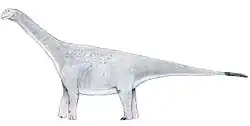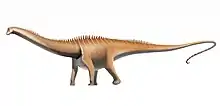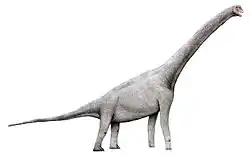| Ruyangosaurus Temporal range: Early Cretaceous, | |
|---|---|
 | |
| Skeleton | |
| Scientific classification | |
| Domain: | Eukaryota |
| Kingdom: | Animalia |
| Phylum: | Chordata |
| Clade: | Dinosauria |
| Clade: | Saurischia |
| Clade: | †Sauropodomorpha |
| Clade: | †Sauropoda |
| Clade: | †Macronaria |
| Clade: | †Titanosauria |
| Genus: | †Ruyangosaurus Lu et al., 2009 |
| Type species | |
| †Ruyangosaurus giganteus Lü et al., 2009 | |
Ruyangosaurus (Ruyang County lizard) is a genus of titanosauriform sauropod dinosaur recovered from the Early Cretaceous Haoling Formation of China. The type species is R. giganteus, described in 2009 by Lü Junchang et al.[1]
Description
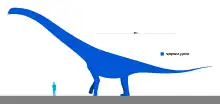
Along with Huanghetitan and Daxiatitan, Ruyangosaurus is among the largest dinosaurs discovered in Cretaceous Asia. In 2016 Gregory S. Paul gave a length of 30 meters (98 ft) and a weight of 50+ tonnes (55 short tons) - making it a 'mega-sauropod'.[2] According to another estimate, Ruyangosaurus was probably about 35 meters (115 ft) long, as evidenced by its 207 cm long femur and 127 cm long right tibia.[3] In 2020 Molina-Perez and Larramendi gave a lower estimation of 24.8 meters (81.4 ft) and 34 tonnes (37.5 short tons).[4]
Classification
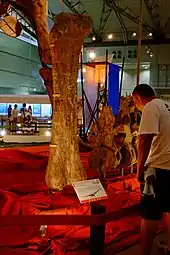

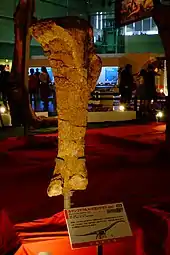
The describers of Ruyangosaurus assigned it to Andesauridae.[1] However, Andesauridae is not monophyletic and, as such, is no longer used.[5]
Comprehensive phylogenetic analyses of Titanosauriformes conducted by Philip Mannion and colleagues in 2013 found Ruyangosaurus to be in a polytomy with Andesaurus and other basal titanosaurs and near-titanosaur somphospondyls, supporting the original description's assertion of phylogenetic proximity of it and Andesaurus, though not the precise taxonomic assignment, with further modifications of the dataset resolving similar conclusions.[6][7][8] However, not all phylogenetic analyses have supported its position as a somphospondyl. A phylogenetic dataset following the description of additional material for Ruyangosaurus to be a non-titanosauriform macronarian, closely related to Yunmenglong.[9]
The phylogenetic analysis of Mannion et al. in 2019 incorporated these updated discoveries into their earlier analysis, along with additional new knowledge for other mid-Cretaceous Asian taxa considered close to Titanosauria. They found Ruyangosaurus to either be close to Andesaurus as a basal titanosaur when all characters were considered equally important, or in a large clade of early titanosaurs potentially given the name Euhelopodidae related to taxa like Yongjinglong and Huanghetitan ruyangensis. Two trees of the results are shown below, equal weighting displaying the results of basal titanosauria, and relationships within Euhelopodidae of extended-implied weighting with a mild down-weighting of highly variable characters (k=9).[10]
Habitat
Ruyangosaurus shared its habitat with Xianshanosaurus, "Huanghetitan" ruyangensis, Yunmenglong, Luoyanggia, and Zhongyuansaurus. The horizon of Ruyangosaurus was originally described as being of "early Late Cretaceous" age,[1] but recent work has assigned it an Aptian-Albian Age based on fieldwork and analysis of invertebrate and microfossil assemblages.[11]
See also
References
- 1 2 3 Lü, J; Xu, L; Jia, S; Zhang, X; Zhang, J; Yang, L; You, H; Ji, Q (2009). "A new gigantic sauropod dinosaur from the Cretaceous of Ruyang, Henan, China". Geological Bulletin of China. 28 (1): 1–10.
- ↑ Paul, Gregory S. (2016). The Princeton Field Guide to Dinosaurs 2nd edition. Oxford: Princeton University Press. p. 231. ISBN 9780691167664.
- ↑ Jinyou Mo, Jincheng Li, Yunchuan Ling, Eric Buffetaut, Suravech Suteethorn Varavud, Suteethorne Haiyan Tong, Gilles Cuny, Romain Amiot & Xing Xu (2020). New fossil remain of Fusuisaurus zhaoi (Sauropoda: Titanosauriformes) from the Lower Cretaceous of Guangxi, southern China. Cretaceous Research: 104379 (advance online publication). doi: https://doi.org/10.1016/j.cretres.2020.104379
- ↑ Molina-Perez and Larramendi (2020). Dinosaur Facts and Figures: The Sauropods and Other Sauropodomorphs. New Jersey: Princeton University Press. p. 261.
- ↑ Mannion, Philip D.; Calvo, Jorge O. (2011). "Anatomy of the basal titanosaur (Dinosauria, Sauropoda) Andesaurus delgadoi from the mid-Cretaceous (Albian-early Cenomanian) Río Limay Formation, Neuquén Province, Argentina: implications for titanosaur systematics". Zoological Journal of the Linnean Society. 163: 155–181. doi:10.1111/j.1096-3642.2011.00699.x.
- ↑ Mannion, Philip D.; Upchurch, Paul; Barnes, Rosie N.; Mateus, Octávio (2013). "Osteology of the Late Jurassic Portuguese sauropod dinosaur Lusotitan atalaiensis (Macronaria) and the evolutionary history of basal titanosauriforms". Zoological Journal of the Linnean Society. 168: 98–206. doi:10.1111/zoj.12029.
- ↑ Mannion, Philip D.; Allain, Ronan; Moine, Olivier (2017). "The earliest known titanosauriform sauropod dinosaur and the evolution of Brachiosauridae". PeerJ. 5: e3217. doi:10.7717/peerj.3217. PMC 5417094. PMID 28480136.
- ↑ Royo-Torres, Rafael; Upchurch, Paul; Kirkland, James I.; DeBlieux, Donald D.; Foster, John R.; Cobos, Alberto; Alcalá, Luis (2017). "Descendants of the Jurassic turiasaurs from Iberia found refuge in the Early Cretaceous of western USA". Scientific Reports. 7 (1): 14311. doi:10.1038/s41598-017-14677-2. PMC 5662694. PMID 29085006.
- ↑ Lü, Junchang; Pu, Hanyong; Xu, Li; Jia, Songhai; Zhang, Jiming; Shen, Caizhi (2014). Osteology of the giant sauropod dinosaur Ruyangosaurus giganteus Lü et al., 2009. Beijing: Geological Publishing House. ISBN 978-7-116-09074-3.
- ↑ Mannion, P.D.; Upchurch, P.; Jin, X.; Zheng, W. (2019). "New information on the Cretaceous sauropod dinosaurs of Zhejiang Province, China: impact on Laurasian titanosauriform phylogeny and biogeography". Royal Society Open Science. 6 (8): 191057. doi:10.1098/rsos.191057. PMC 6731702. PMID 31598266.
- ↑ Xu, L., Pan, Z.C., Wang, Z.H., Zhang, X.L., Jia, S.H., Lü, J.C., Jiang, B.L., 2012. Discovery and significance of the Cretaceous system in Ruyang Basin, Henan Province. Geological Review 58, 601-613.





